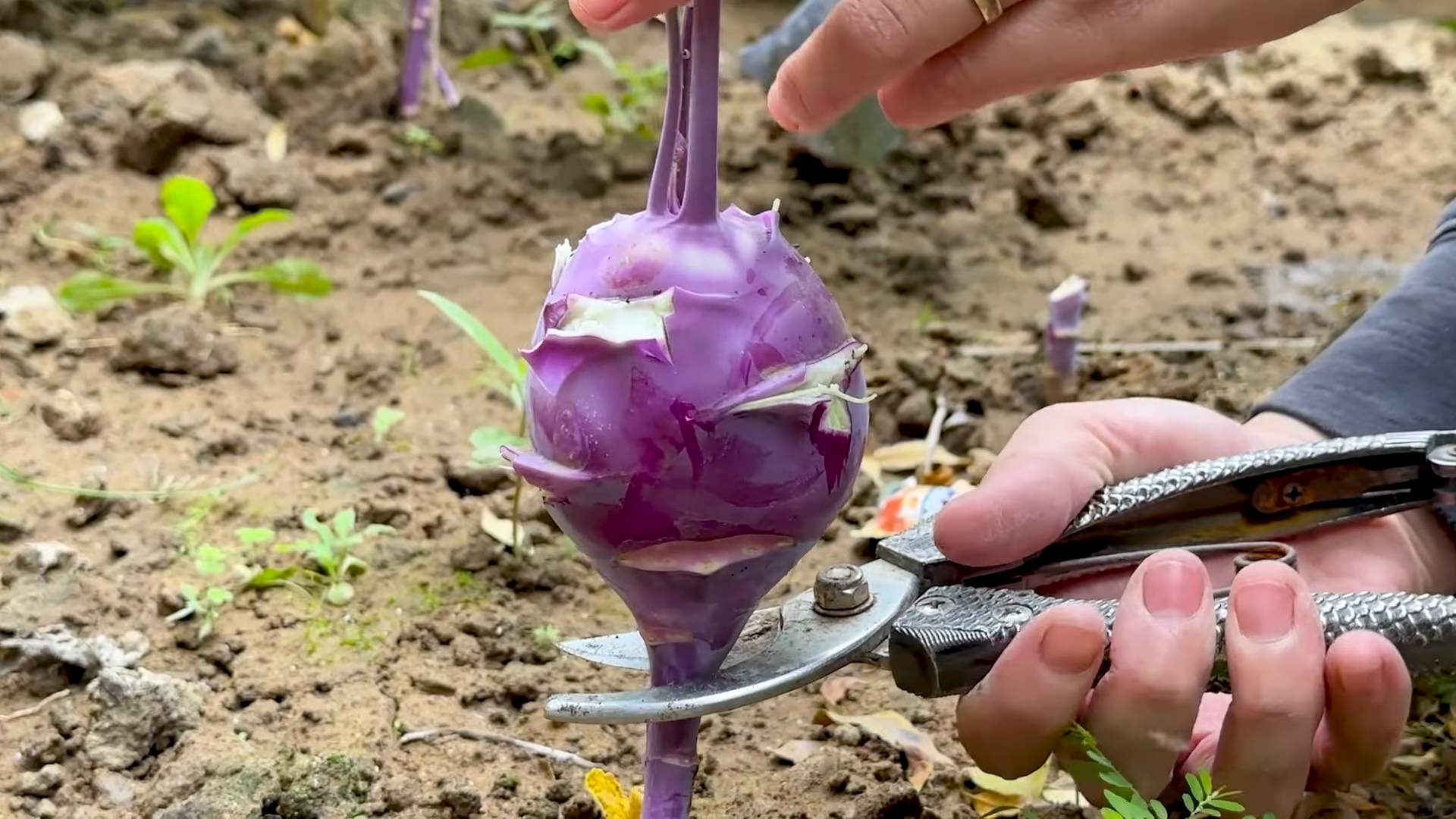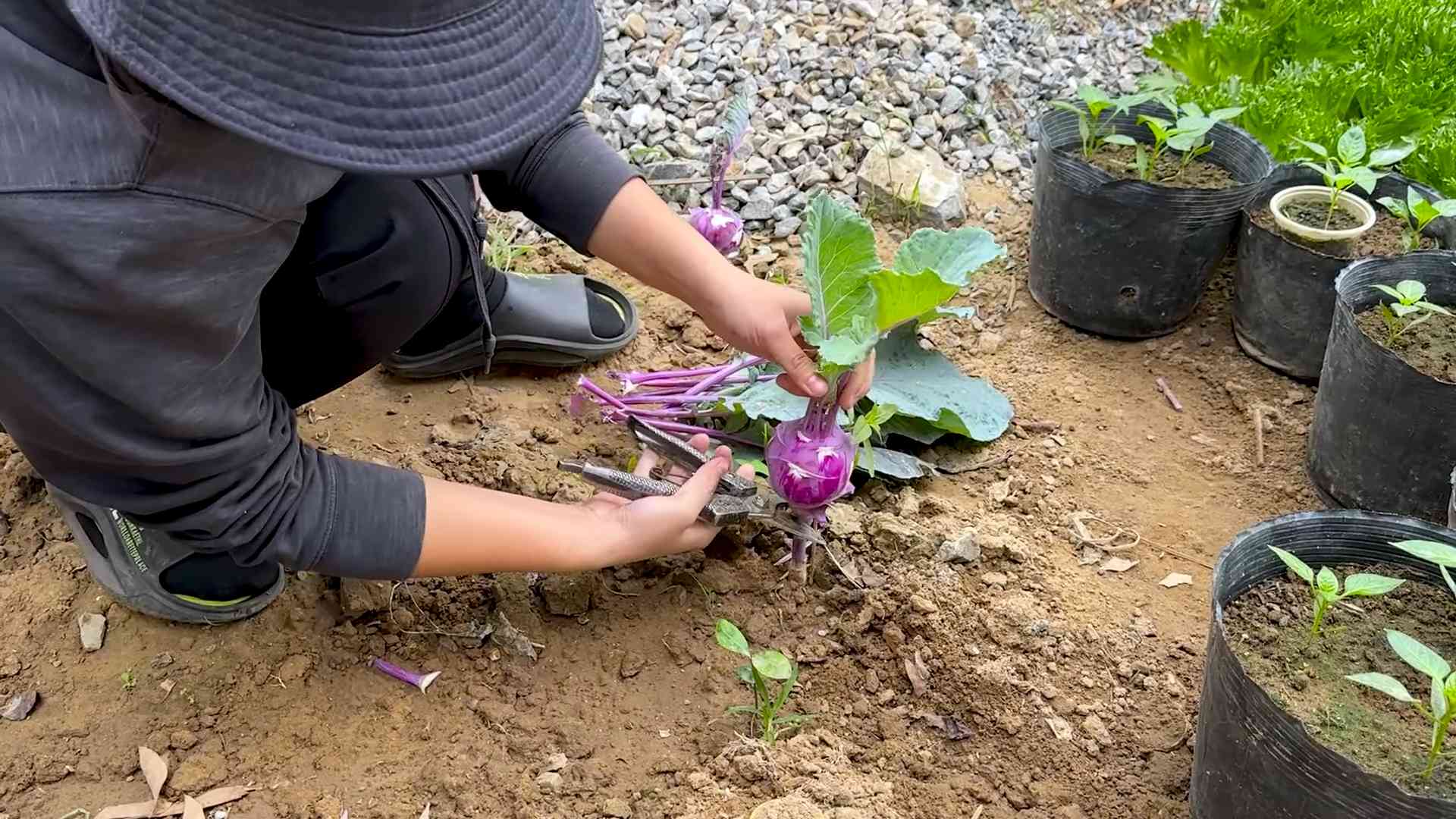Grow Kohlrabi Continuous Yield: Imagine stepping into your garden and harvesting fresh, crisp kohlrabi whenever you crave it. No more waiting for that single, fleeting harvest window! That’s the magic we’re unlocking today with a simple, yet incredibly effective DIY trick to achieve a continuous kohlrabi yield.
Kohlrabi, sometimes called a German turnip, has a fascinating history. Originating in Europe, it was popularized as a hearty and versatile vegetable, enjoyed both raw and cooked. For centuries, gardeners have sought ways to extend its growing season, and now, I’m excited to share a method that takes that desire to the next level.
Let’s face it, gardening can be unpredictable. Pests, weather, and timing all play a role. But with this DIY hack, you can take control and ensure a steady supply of this delicious and nutritious vegetable. Many gardeners struggle with the “feast or famine” cycle of kohlrabi, harvesting everything at once and then waiting months for the next crop. This trick eliminates that problem, providing a consistent harvest throughout the growing season. So, if you’re ready to grow kohlrabi continuous yield and enjoy fresh kohlrabi all season long, let’s dive in!

DIY: Never-Ending Kohlrabi Harvest – A Guide to Continuous Yield
Hey there, fellow gardeners! Are you as obsessed with kohlrabi as I am? That crisp, slightly sweet, and oh-so-versatile veggie is a staple in my kitchen. But you know what’s even better than a single kohlrabi harvest? A *continuous* kohlrabi harvest! That’s right, we’re talking about enjoying fresh kohlrabi all season long. And guess what? It’s totally achievable with a few simple tricks. Let’s dive in!
Understanding the Kohlrabi Life Cycle for Continuous Harvesting
Before we get our hands dirty, it’s important to understand how kohlrabi grows. This will help us plan our planting schedule for a continuous harvest.
* Kohlrabi is a cool-season crop: It thrives in temperatures between 60-75°F (15-24°C). Hot weather can cause it to bolt (go to seed), resulting in a tough and bitter bulb.
* Quick grower: Kohlrabi matures relatively quickly, typically in 45-60 days from seed. This makes it perfect for succession planting.
* Succession planting is key: This involves planting new kohlrabi seeds every 2-3 weeks to ensure a continuous supply.
* Variety selection matters: Choose varieties with different maturity dates to further extend your harvest window.
Getting Started: Materials and Preparation
Alright, let’s gather our supplies. Here’s what you’ll need:
* Kohlrabi seeds: Choose varieties like ‘Early White Vienna,’ ‘Purple Vienna,’ ‘Grand Duke,’ or ‘Kossak’ (for larger bulbs). I personally love ‘Early White Vienna’ for its mild flavor and quick maturity.
* Seed starting trays or pots: If you’re starting seeds indoors.
* Seed starting mix: A light and well-draining mix is essential.
* Garden soil: Amend your garden soil with compost or well-rotted manure for optimal growth.
* Fertilizer: A balanced fertilizer (10-10-10) or a fertilizer specifically formulated for vegetables.
* Watering can or hose: For regular watering.
* Row covers (optional): To protect seedlings from pests and frost.
* Garden tools: Trowel, hand rake, etc.
* Labels and a marker: To keep track of your plantings.
Phase 1: Starting Your Kohlrabi Seeds
You can either direct sow your kohlrabi seeds or start them indoors. I prefer starting them indoors, especially for the early spring planting, as it gives them a head start.
1. Sow seeds indoors (optional): About 4-6 weeks before the last expected frost, fill your seed starting trays or pots with seed starting mix. Sow 2-3 seeds per cell, about ¼ inch deep. Gently water the soil.
2. Provide warmth and light: Place the trays in a warm location (around 70°F or 21°C) or use a heat mat. Once the seeds germinate, move them under grow lights or to a sunny windowsill.
3. Thin seedlings: Once the seedlings have their first true leaves, thin them to one plant per cell. Choose the strongest seedling and snip off the others at the soil line.
4. Harden off seedlings: About a week before transplanting, gradually acclimate the seedlings to outdoor conditions. Start by placing them outside for a few hours each day, increasing the time each day.
Phase 2: Preparing Your Garden Bed
Kohlrabi needs well-drained, fertile soil to thrive. Let’s get your garden bed ready.
1. Choose a sunny location: Kohlrabi needs at least 6 hours of sunlight per day.
2. Prepare the soil: Loosen the soil to a depth of 12 inches. Remove any rocks, weeds, or debris.
3. Amend the soil: Incorporate plenty of compost or well-rotted manure into the soil. This will improve drainage, fertility, and water retention.
4. Check the pH: Kohlrabi prefers a soil pH between 6.0 and 7.5. If your soil is too acidic, add lime. If it’s too alkaline, add sulfur. You can get a soil testing kit at most garden centers.
5. Fertilize: Apply a balanced fertilizer (10-10-10) according to the package directions.
Phase 3: Planting Your Kohlrabi
Now for the fun part – planting! Remember, we’re aiming for a continuous harvest, so we’ll be planting in succession.
1. Transplant seedlings (if applicable): Once the danger of frost has passed and your seedlings are hardened off, transplant them into your prepared garden bed. Space them 6-8 inches apart in rows that are 12-18 inches apart.
2. Direct sow seeds (alternative): If you’re direct sowing, sow seeds about ½ inch deep and 1 inch apart. Thin the seedlings to 6-8 inches apart once they have their first true leaves.
3. Water thoroughly: After planting, water the seedlings or seeds thoroughly.
4. Apply mulch: Mulch around the plants with straw, wood chips, or shredded leaves. This will help retain moisture, suppress weeds, and regulate soil temperature.
5. Succession planting: This is the most important step for a continuous harvest! Every 2-3 weeks, plant another batch of kohlrabi seeds, either indoors or directly in the garden. I usually mark my calendar to remind myself.
Phase 4: Caring for Your Kohlrabi Plants
Consistent care is essential for healthy kohlrabi plants and a bountiful harvest.
1. Water regularly: Kohlrabi needs consistent moisture, especially during bulb development. Water deeply whenever the top inch of soil feels dry. Aim for about 1 inch of water per week.
2. Fertilize: Side-dress your kohlrabi plants with a balanced fertilizer every 3-4 weeks. Follow the package directions.
3. Weed regularly: Keep the garden bed free of weeds, as they can compete with the kohlrabi plants for nutrients and water.
4. Pest control: Keep an eye out for pests like cabbage worms, aphids, and flea beetles. Use organic pest control methods like insecticidal soap or neem oil if necessary. Row covers can also help prevent pest infestations.
5. Monitor for bolting: If the weather gets too hot, kohlrabi can bolt (go to seed). This will make the bulb tough and bitter. If bolting occurs, harvest the kohlrabi immediately, even if it’s not fully mature. You can still eat the leaves, which are similar to kale.
Phase 5: Harvesting Your Kohlrabi
The moment we’ve been waiting for! Harvesting your delicious kohlrabi.
1. Harvest when the bulb is the right size: Kohlrabi is typically harvested when the bulb is 2-3 inches in diameter. Larger bulbs can become tough and woody.
2. Check the maturity date: Refer to the seed packet for the expected maturity date of your kohlrabi variety.
3. Harvest by cutting the stem: Use a sharp knife to cut the stem just above the soil line.
4. Remove the leaves: Remove the leaves from the bulb. You can eat the leaves, but they are best when young and tender.
5. Store properly: Store kohlrabi bulbs in the refrigerator for up to several weeks.
Tips and Tricks for a Supercharged Kohlrabi Harvest
Here are a few extra tips to help you maximize your kohlrabi harvest:
* Choose the right varieties: As mentioned earlier, select varieties with different maturity dates to extend your harvest window.
* Plant in partial shade during hot weather: If you live in a hot climate, plant kohlrabi in partial shade to prevent bolting.
* Use row covers: Row covers can protect your plants from pests, frost, and excessive sunlight.
* Don’t let the bulbs get too big: Overly large kohlrabi bulbs can become tough and woody. Harvest them when they are the right size.
* Experiment with different planting times: Adjust your planting schedule based on your local climate and growing conditions.
* Enjoy your harvest! Kohlrabi can be eaten raw, cooked, or pickled. It’s delicious in salads, slaws, stir-fries, and soups.
Troubleshooting Common Kohlrabi Problems
Even with the best planning, you might encounter a few problems along the way. Here’s how to troubleshoot some common kohlrabi issues:
* Bolting: This

Conclusion
So, there you have it! Mastering the art of continuous kohlrabi harvesting is not just about planting; it’s about understanding the plant’s growth cycle and implementing a strategic approach to ensure a steady supply of this delicious and versatile vegetable. This DIY trick, focusing on succession planting and optimal growing conditions, is a game-changer for any gardener, whether you’re a seasoned pro or just starting out.
Why is this a must-try? Because it transforms your kohlrabi patch from a one-time harvest into a season-long bounty. Imagine fresh, crisp kohlrabi available whenever you need it, ready to be transformed into slaws, stir-fries, or simply enjoyed raw with a dip. No more waiting impatiently for weeks, only to be overwhelmed by a glut of kohlrabi all at once. This method allows you to savor the unique flavor and texture of kohlrabi throughout the growing season.
Beyond the basic method, there are plenty of ways to customize this approach to suit your specific needs and preferences. Consider experimenting with different kohlrabi varieties. Some mature faster than others, allowing you to fine-tune your planting schedule for even more consistent harvests. For example, ‘Early White Vienna’ is known for its quick maturity, while ‘Purple Vienna’ offers a beautiful color contrast in your garden and on your plate.
Another variation involves intercropping. Plant quick-growing radishes or lettuce between your kohlrabi rows. These crops will mature and be harvested before the kohlrabi needs the space, maximizing your garden’s productivity. You can also adjust the frequency of your succession plantings based on your consumption habits. If you only need a few kohlrabi per week, space your plantings further apart. If you’re a kohlrabi fanatic, plant more frequently.
Don’t forget about soil health! Regularly amend your soil with compost or other organic matter to provide your kohlrabi plants with the nutrients they need to thrive. Consistent watering is also crucial, especially during hot, dry periods. Mulching around your plants will help retain moisture and suppress weeds, further contributing to a successful continuous harvest.
Ultimately, the key to successful continuous kohlrabi harvesting lies in observation and adaptation. Pay attention to your plants, monitor the weather, and adjust your planting schedule as needed. Don’t be afraid to experiment and find what works best for you and your garden.
We wholeheartedly encourage you to try this DIY trick for continuous kohlrabi yields. It’s a rewarding experience that will not only provide you with a steady supply of fresh vegetables but also deepen your connection to the natural world. Once you’ve given it a try, we’d love to hear about your experience! Share your tips, successes, and even your challenges in the comments below. Let’s learn from each other and create a community of thriving kohlrabi gardeners! Let us know what variety of kohlrabi you planted, what your planting schedule was, and any other tips you found helpful. Happy gardening!
Frequently Asked Questions (FAQ)
What exactly is succession planting, and why is it important for continuous kohlrabi harvesting?
Succession planting is the practice of planting crops at staggered intervals to ensure a continuous harvest over a longer period. For kohlrabi, this means planting a small batch of seeds or seedlings every 2-3 weeks, rather than planting everything at once. This is crucial because kohlrabi matures relatively quickly (around 50-60 days), so a single planting would result in a large harvest all at once, followed by a period with no kohlrabi. Succession planting eliminates this feast-or-famine cycle, providing a steady supply of fresh kohlrabi throughout the growing season.
How often should I plant kohlrabi seeds for continuous harvesting?
A good starting point is to plant a new batch of kohlrabi seeds or seedlings every 2-3 weeks. However, the ideal frequency will depend on several factors, including your local climate, the specific kohlrabi variety you’re growing, and your personal consumption habits. If you live in a warmer climate, kohlrabi will mature faster, so you may need to plant more frequently. Conversely, in cooler climates, you can space your plantings further apart. Monitor your plants closely and adjust your planting schedule accordingly.
What are the best kohlrabi varieties for continuous harvesting?
While any kohlrabi variety can be grown using the succession planting method, some varieties are better suited for it than others. Look for varieties that are known for their quick maturity and disease resistance. ‘Early White Vienna’ and ‘Early Purple Vienna’ are popular choices for their fast growth and reliable yields. ‘Grand Duke’ is another excellent option, known for its large, uniform bulbs and resistance to bolting (going to seed prematurely). Experiment with different varieties to find the ones that perform best in your garden.
What kind of soil and sunlight do kohlrabi plants need?
Kohlrabi thrives in well-drained, fertile soil that is rich in organic matter. Amend your soil with compost or other organic matter before planting to improve its drainage and nutrient content. Kohlrabi prefers full sun (at least 6 hours of direct sunlight per day), but it can tolerate partial shade, especially in hotter climates. Make sure to choose a planting location that receives adequate sunlight and has good drainage.
How much water do kohlrabi plants need?
Kohlrabi plants need consistent moisture to thrive. Water deeply and regularly, especially during hot, dry periods. Aim to keep the soil consistently moist but not waterlogged. Mulching around your plants will help retain moisture and suppress weeds. A good rule of thumb is to water when the top inch of soil feels dry to the touch.
What are some common pests and diseases that affect kohlrabi, and how can I prevent them?
Common pests that affect kohlrabi include cabbage worms, aphids, and flea beetles. Diseases include clubroot and downy mildew. To prevent these problems, practice good garden hygiene, such as removing plant debris and weeds. Use row covers to protect your plants from pests. Choose disease-resistant varieties. If you encounter pests or diseases, treat them promptly with appropriate organic or chemical controls. Crop rotation can also help prevent soilborne diseases.
Can I grow kohlrabi in containers?
Yes, kohlrabi can be successfully grown in containers, making it a great option for gardeners with limited space. Choose a container that is at least 12 inches deep and wide to provide enough room for the roots to grow. Use a high-quality potting mix and ensure that the container has good drainage. Water regularly and fertilize every few weeks with a balanced fertilizer.
How do I know when kohlrabi is ready to harvest?
Kohlrabi is typically ready to harvest when the bulb is about 2-3 inches in diameter. The exact size will depend on the variety. The bulb should be firm and smooth. Don’t let the bulb get too large, as it can become tough and woody. Harvest by cutting the bulb from the stem just above the soil line.
What are some ways to use kohlrabi in cooking?
Kohlrabi is a versatile vegetable that can be used in a variety of dishes. It can be eaten raw, cooked, or pickled. Raw kohlrabi has a crisp, slightly sweet flavor and can be grated into salads or used as a crudité. Cooked kohlrabi can be steamed, boiled, roasted, or stir-fried. It can also be added to soups, stews, and gratins. The leaves of the kohlrabi plant are also edible and can be used like collard greens or kale.
What if my kohlrabi bolts (goes to seed prematurely)?
Bolting can be caused by stress, such as extreme temperatures or inconsistent watering. Once kohlrabi bolts, the bulb becomes tough and bitter. To prevent bolting, choose bolt-resistant varieties, provide consistent watering, and protect your plants from extreme temperatures. If your kohlrabi does bolt, you can still harvest the leaves, which are still edible.





Leave a Comment